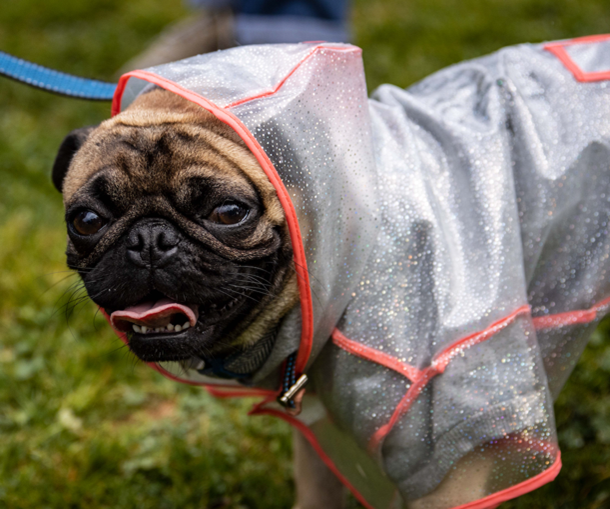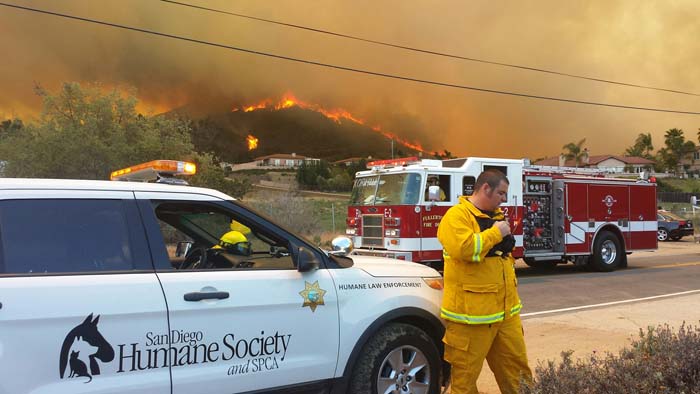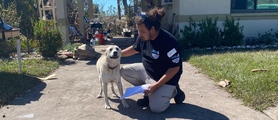Response: ABC 10 News Community Cat Program Story
March 4, 2022
On Monday, Feb. 28, ABC 10 News aired a story that included several inaccurate statements about San Diego Humane Society’s Community Cat Program. Community cats are specifically outdoor cats with no verifiable signs of ownership. We want to ensure our community has the necessary information to understand our Community Cat Program and how we are working to do what’s best for cats throughout San Diego County.
San Diego Humane Society and other leading animal welfare organizations nationwide are creating comprehensive community cat programs to best meet the needs of individual cats while helping to reduce the population of community cats over time. Supporters of these programs include veterinarians, shelter experts and animal welfare organizations — including Best Friends Animal Society, the National Animal Control Association, California Animal Welfare Association (CalAnimals), Alley Cat Allies, American Pets Alive, the American Society for the Prevention of Cruelty to Animals (ASPCA), the Humane Society of the United States (HSUS), the Koret Shelter Medicine Program at the University of California, Davis, and Maddie’s Shelter Medicine Program at the University of Florida.
Our Community Cat Program is based on more than a decade of internationally recognized scientific research, as well as discussion and debate among those in the animal welfare community who have dedicated their lives to doing what’s best for animals. It specifically addresses the welfare of unowned, outdoor cats. These cats can be friendly or feral, young or old. Community cats who enter the program are spayed/neutered, medically evaluated, vaccinated and quickly returned to their outdoor homes. This program only applies to healthy community cats, and those with easily treatable conditions, who demonstrate they are doing well living outside. It does not apply to cats who are unhealthy, show signs of having been abandoned, were relinquished by their owners, or were found in a location that presents an immediate danger.
We understand that there may be questions about our program, particularly as they relate to the ABC 10 News story. The perspective in the story was limited and did not represent our Community Cat Program or the stories of the individual cats accurately. To provide a more detailed picture, we would like to clarify and correct the following statements from the ABC 10 News story:
-
The story stated that we are “releasing friendly, domesticated cats back onto the streets.” It is misleading and factually incorrect for ABC 10 News to state that we release cats “onto the streets.” Cats are returned to their outdoor homes, which include neighborhoods and areas where they have been living successfully. There are multiple reasons to return healthy cats, regardless of their temperament, to their outdoor homes. In addition to helping to stabilize and reduce the size and number of community cat colonies, this approach allows community cats, regardless of their temperament, to avoid the stresses associated with living in a shelter. Even for friendly community cats, confinement in a shelter — even for a short period of time — can expose them to potential illness and cause extreme stress, which can lead to significant health and welfare problems, including increased rates of death in shelter care and euthanasia. Additionally, many friendly community cats are social because they do interact frequently with humans in their neighborhoods, including people who may act as their caregivers. While caregiving differs significantly from ownership in the traditional and legal sense of the word, caregivers may provide these cats with food and water, access to their yards, and human interaction and affection — and, in many cases, these caregivers are significantly invested in the cats’ wellbeing. Friendliness in a community cat indicates that they have an outdoor home in which they are thriving. Therefore, regardless of their behavior, the best outcome for healthy community cats is to spay/neuter and vaccinate them, and return them to their outdoor homes.
-
The news story claimed that “friendly adoptable cats are never given the chance to find a home.” This is inaccurate and misleading. When community cats are brought to us, we assess each one individually to determine the best outcome for every cat. That outcome may well be adoption. And only cats identified as community cats – living outdoors and thriving — are returned to their outdoor homes. Lost cats with verifiable signs of ownership and cats who are surrendered by their owners to the shelter are not eligible for the Community Cat Program. From July 2021 through January 2022, 70% of cats brought to San Diego Humane Society were returned outdoors while 23% were admitted into the shelter for lost and found services, adoption into a home, entry into our Working Cat Program, transfer to one of our rescue partners or other pathway.
-
In the story, attorney Bryan Pease states that releasing friendly cats outdoors “constitutes illegal animal abandonment.” This is inaccurate. Our Community Cat Program does not conflict with California law, and so far Mr. Pease’s arguments have been rejected in court. In fact, our Community Cat Program aligns closely with California’s public policy regarding animals. California’s anti-cruelty laws are designed to prevent unnecessary pain and suffering in animals, as well as abandonment of animals by their owners. Community cats have no verifiable owner, and the vast majority are healthy and benefit from being sterilized, vaccinated and returned to the location where they were found. The Community Cat Program saves cats’ lives, provides humane treatment in accordance with California state law and policy, minimizes reproduction and reduces nuisance concerns.
-
Pease also states that the cats we return outdoors “are unable to survive on their own. They’re completely dependent on humans.” This is inaccurate. Cats live and thrive outdoors all over the world — in Africa, Asia, Australia, South America and beyond. Even in the United States, keeping indoor cats as pets only became popular after 1947, with the invention of cat litter, and then became more commonplace in the 1970s when shelters advocated for keeping cats indoors in an effort to control population. Additionally, cats — unlike their canine counterparts — have DNA that has remained unchanged for the past 4 million years. Cats today are still virtually identical to those who have thrived outside for millions of years! According to National Geographic, a study that compared the DNA of cats throughout history shows that no major differences exist between the genetic makeup of wild and domestic cats. As a result, they remain perfectly capable of not just surviving, but doing well, on their own.
-
The story painted an inaccurate picture of what happens to community cats after they are returned to their outdoor homes. It stated that “the shelters can brag how they didn’t have to euthanize any cats. But what they are not saying is these cats are being dumped back onto the streets and will likely suffer and die in some horrific manner.” This is false, as confirmed by decades of scientific data. There have been no documented increases in cats dying or being injured in communities that have adopted community cat programs. In fact, studies suggest that community cat programs lead to a decrease in the number of deceased cat pickups. In a study titled “Study of the effect on shelter cat intakes and euthanasia from a shelter neuter return project of 10,080 cats from March 2010 to June 2014” (K. Johnson, et al., 2014), findings showed a 20% reduction in deceased cat pickup after implementing a program to sterilize and return cats to their outdoor homes. According to a 2012 study titled “Frequency of Lost Dogs and Cats in the United States and Methods Used to Locate Them” (E. Weiss, et al.), deceased cat pickup was reduced by 24%. Additionally, the goal of our Community Cat Program is not to reduce our euthanasia numbers. It is to reduce the overall population of community cats while doing what’s best for every cat.
-
The story states that “every community cat loses the top of an ear.” Each community cat, after being sterilized, has an ear “tipped,” and this universally adopted procedure is performed under anesthesia at the time of spay/neuter. This is a common symbol, used nationwide, that indicates a community cat has already been sterilized, meaning they can be left undisturbed in their outdoor home. It is how San Diego Humane Society and our partner organizations know they’ve already been spayed or neutered.
-
The story presented data that was limited and does not accurately reflect the success of San Diego Humane Society's work to save cats throughout San Diego County. The data set reflected primarily adult cats who were specifically found outside and brought to the shelter, not ALL of the cats brought to the shelter or already in the shelter receiving care (which includes cats who are surrendered by their owners, admitted for emergency boarding or seized by Humane Law Enforcement; kittens younger than 6 months old; and animals transferred into or born in the shelter). When ALL cats cared for by San Diego Humane Society are taken into account, the outcomes are as follows: 67% were adopted, returned to an owner or transferred to another animal welfare organization; 23% were returned to their outdoor homes; and 10% were humanely euthanized or had an unassisted death.
-
The story included information about three specific cats who were part of our Community Cat Program:
-
Jordy: Jordy was initially brought to San Diego Humane Society on June 5, 2021. He had no verifiable signs of ownership and a wound on his side. Jordy’s finder expressed willingness to pick him up and monitor him. After Jordy received significant medical treatment at San Diego Humane Society from June 5-9, his finder picked him up and was asked to monitor him for a few days before releasing him to his outdoor home. On June 11, Jordy was brought back to San Diego Humane Society for evaluation due to his wound reopening. The wound reopening was repaired and rechecked by our medical team before he was returned to his finder at their request. We communicated with one of our local rescue partners about transferring Jordy into their care (to avoid a stay in our shelter, which would have been challenging for him) if it was determined that further medical treatment would be needed. They agreed that it would be best for Jordy to remain in the Community Cat Program as long as the identified caretaker was engaged and willing to monitor him, which they were. On June 24, Jordy was brought back a third time for additional evaluation of his wound reopening. The wound was repaired and monitored before Jordy was returned to his finder again on June 26. Jordy’s story may raise the question of why, with so many rechecks of a wound that wasn’t healing quickly in his outdoor home, he wasn’t taken into the shelter. If there wasn’t an established caretaker who had agreed to monitor his progress, we would absolutely take a community cat like Jordy into shelter care.
Jordy’s finder presented herself as his caretaker and agreed to monitor him. It was also known to staff that Jordy came from a local community cat colony with other established caretakers and feeders who know they can bring cats to us for treatment and rechecks as necessary. Without all of those circumstances in place, Jordy would not have remained in the Community Cat Program and instead would have been placed into the shelter or transferred to a rescue partner.
-
Mango: Mango was brought to San Diego Humane Society on Sept. 12, 2020 with notes that she belonged to an established local community cat colony with a known caretaker. She was spayed, vaccinated, and treated for fleas and sarcoptic mange (scabies). Scabies is a simple, treatable skin condition, often cured with one single of dose of medication. Although it looks unsightly, our veterinarians explained that the scabies wouldn’t have physically weakened Mango or prevented her from taking care of herself after being returned to her outdoor home.
While it is tragic that Mango died from a wound that she received after exiting our care, when we released Mango, we had treated her scabies and she was a healthy cat. We never release sick or injured community cats outdoors if their injury or ailment would prevent them from thriving in their outdoor homes. If our veterinarians observed Mango to be weak and unable to care for herself, we wouldn’t have released her.
-
Phyllis: Phyllis was brought to San Diego Humane Society on Feb. 2, 2022 with notes from her finder indicating a concern about her eye and a lump on her side. Upon examination, our medical staff found that this cat was in good health. She did not have any ocular or nasal discharge, and was very bright, alert and responsive. All possible medical concerns were easily addressed and she had no verifiable signs of ownership, meaning she was a candidate for the Community Cat Program.
Phyllis’s subsequent condition of hyperthyroidism was diagnosed by a private veterinarian after bloodwork was performed. We admit more than 35,000 companion animals per year and do not perform routine bloodwork unless there is an indication that there is a medical need, which there was not with Phyllis.
-
Abby: We are unable to find a match for this cat in our records. A social media post suggests her finder may have contacted us or come in two years ago.
Community cat programs are the way forward around the world for outdoor-living cats, and these programs are leading to lifesaving progress for animals. San Diego Humane Society did not begin its program until the value and benefits of such programs were well established and approved by the nation’s experts. Community cat programs are now considered to be the gold standard for progressive, lifesaving pathways for unowned cats who are doing well in their outdoor environments. We are committed to inspiring compassion and creating a better world for animals and the people who love them. To learn more about our Community Cat Program, please visit our FAQs and Research & Resources page.
Published:








